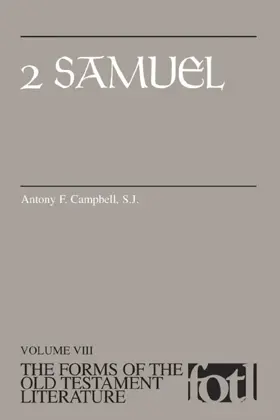

2 Samuel
in Forms of the Old Testament Literature
Pages
256 pages
Publisher
Eerdmans
Published
4/1/2005
ISBN-13
9780802828132
2 Samuel, by Antony F. Campbell, S.J., is Volume VIII of The Forms of the Old Testament Literature, a series that aims to present a form-critical analysis of every book in the Hebrew Bible. Fundamentally exegetical, the FOTL volumes examine the structure, genre, setting, and intention of each textual unit in question. They also study the history behind the form-critical discussion of the material, attempt to bring consistency to the terminology for the genres and formulas of the biblical literature, and expose the exegetical process so as to enable students and pastors to engage in their own analysis and interpretation of the Old Testament texts.
Beginning where he left off in his volume on 1 Samuel, Campbell unpacks the wealth of insight inherent in 2 Samuel by paying close attention to the literary structure of the book. Following a comprehensive introduction, the commentary carefully analyzes the major sections of 2 Samuel and each passage within them. In the process, Campbell reveals the diversity of views that existed in Israel’s traditions, and he highlights the primacy of theology over history in Israel’s thinking.
Reviews
Campbell is sensitive to issues of the book’s development without losing sight of
the fact that this text is a part of the Jewish-Christian canon.
Campbell is sensitive to issues of the book’s development without losing sight of
the fact that this text is a part of the Jewish-Christian canon. Normally, the Old Testament
Library is a good theological series
Form-critical analysis that attempts to identify the genre, setting, and literary features of the narratives.
[Full Review]
Antony Campbell is to be congratulated on the completion of his two-volume �form-critical� study of the books of Samuel�not l east because, like these biblical books, he has told his story well. While starting and finishing with concern for the present text of 2 Samuel, he insists attractively that a �flat text� is like a �flat earth��a hypothesis and against the evidence�and that �form criticism, � while a �red rag� word like �socialized medicine� (his writing is frequently directed to a U.S. readership), is �as unavoidable as breathing.� His introduction outlines fresh thinking on the nature and extent of the �Story of David�s Rise� and what he calls the �Stori es of David�s Middle Years.� The shaping of the commentary conforms to the requirements of the long-familiar series. However, the strength of Campbell�s work throughout resi des principally in the sections labeled �Discussion� together with some of the chap ter openings, in which he offers and defends his reading of the text in substantial portions�a reading atte ntive to the skilled ambiguity of so much of these books. While he insists (7�10), I susp ect rightly, that the books of Samuel are more theological writing than historiography, he does locate the origin of much of their material in �the interpretation of the experience of David�s kingship.
[Full Review]
La premiŁre partie de ce commentaire des livres de Samuel est parue en 2003, et il faut se rØjouir de la parution rapide du deuxiŁme volume, oø l�on retrouve les qualitØs et les limites du premier. En dehors du commentaire proprement dit, plusieurs ØlØments du t. 1 sont d�ailleurs repris�sous une forme plus ou moins remaniØe�dans le second volume: la prØface de l�auteur (xi�xiv), l�introducti on (1�13) et le glossaire (224�32). Le seul ØlØment nouveau est l�appendice sur le r�le fondamental de la Bible (233�42), qui dØveloppe la rØflexion sur la nature de la Bible et ses niveaux de lecture («incarnational», «foundational», «interpretational») proposØe dans l�introduction du premier volume (11�13); si suggestif soit-il, cet appendice m�appara�t comme en porte-�-faux par rapport au commentaire lui-mŒme. Comme il se doit, l�essentiel du livre est consacrØ � la lecture, morceau par morceau, du texte de 2 Samuel. On y trouve chaque fois les mŒmes rubriques: un schØma de la structure du texte, puis un relevØ des principaux problŁmes de critique textuelle («Textual issues»), un dØveloppement de la structure et parfois une proposition relative � l�origine du texte («Discussion»), l�Øtablissement�souvent trŁs rapide�du genre littØrai re («Genre»), et une rØflexion de synthŁse sur la portØe de la pØricope («Meaning»).
[Full Review]


